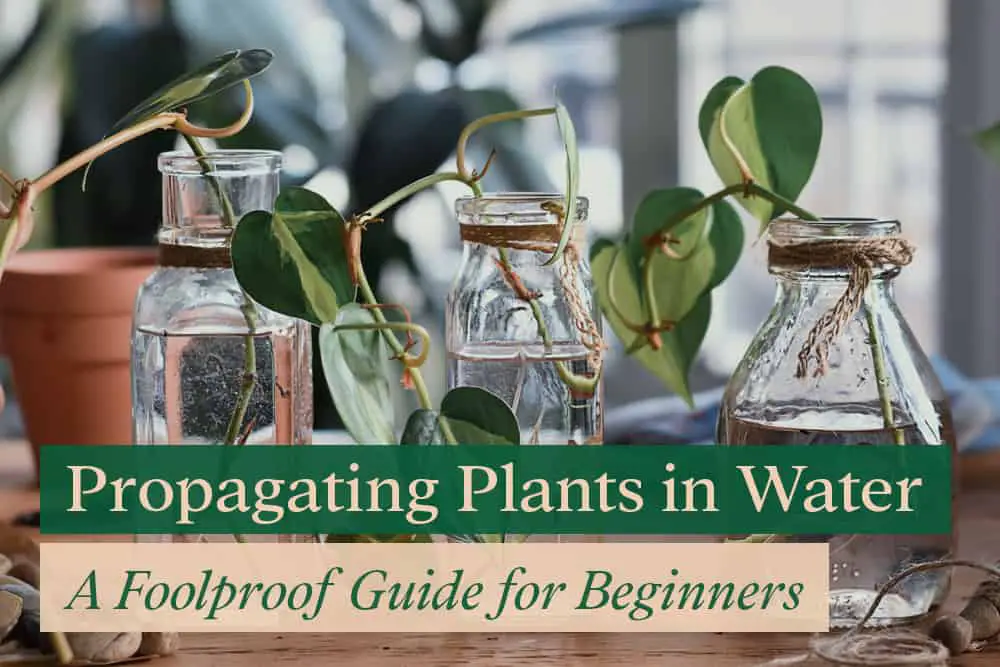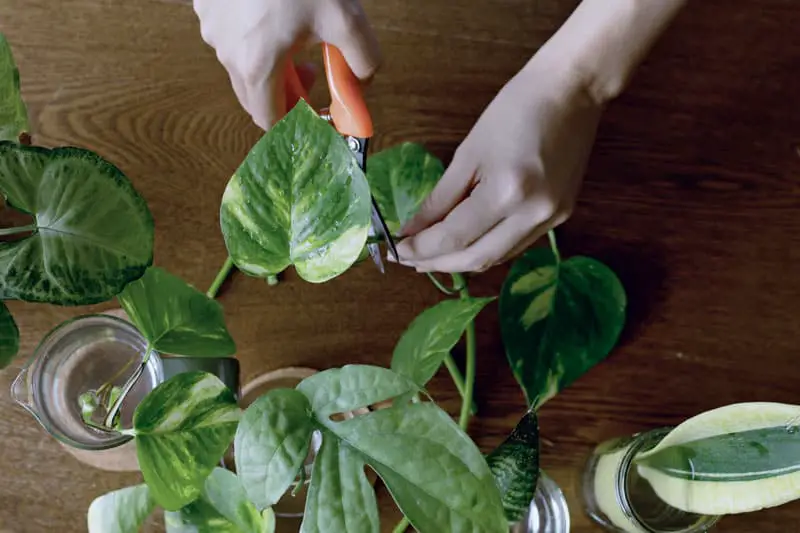
Is this your first time propagating your prized houseplant in water? Are you worried that something will go wrong and the cuttings will die?
Don’t worry! As long as you know what’s required, propagating plants in water is easy and straightforward.
Here I will cover everything you know about water propagation:
- Which is faster, propagating in water or soil?
- A step-by-step guide to rooting in water
- How to promote root development in water propagation
- Why your plant doesn’t grow roots in water
Let’s get started
Disclaimer: As an Amazon Associate I earn from qualifying purchases.
Propagating in Water vs. Soil, Which Is Faster?
I’m sure you are wondering which medium will help your plant cuttings root faster.
Generally, water roots grow faster compared to soil roots as they need less energy to develop. Within 2 weeks, water roots begin to develop, while soil roots take about 3 to 4 weeks to start growing.
But, this is not always the case.
Plants with a hard cutting sometimes take longer to root than soft cuttings, whether in soil or water.
This YouTube video compares plants propagated in water and potting soil and how quickly they sprouted roots in both mediums:
Nevertheless, water roots are usually more hairy, white, and fragile than soil roots. To ensure that your plants grow to their full potential growth, they must be transplanted into soil once the water roots have formed.
Rooting Process
Once you’ve identified the plant you want to propagate in water, you can start the rooting process.
The advantage of water propagation is you can keep an eye on the rooting process, so you can tell if the propagation is a success or not.
The rooting process is essentially the same for most house plants. Here are the steps to follow:

- Snip the cutting from the parent plant. Cut at least ¼ inches (0.5 cm) below the plant’s node using a sharp knife.
- You should get several cuttings if you want to fill your pot with new plants or give multiple plants as gifts.
- Place the cuttings in a clean jar. Make sure you remove any leaves that may become submerged in water. To reduce water loss, keep two or three upper leaves on a plant with many leaves.
- Add water to the glass jar until the nodes are covered. Most plants will root in tap water. However, spring water will provide additional minerals to boost plant growth.
- Replace the water every 3-5 days with fresh water. You should change the water sooner if it becomes murky. Otherwise, the cuttings will rot.
- Observe the plant for signs of roots. Some plants root within two or three weeks. Others may take months to develop roots.
- The plant can be transplanted into the soil once it has sufficient root development (at least two to four inches).
Once plants propagated in water begin rooting, their roots continue to grow. However, they’ll remain thin and appear fragile because they have easy access to water and oxygen.
Leaving plants in water for too long may cause them to rot, so it is best to transfer them to the soil when their roots have grown sufficiently.
New Leaf and Plant Growth
Now, the question is, will your plant grow new leaves if it is propagated in water?

Generally, water roots must develop before a new leaf appears on a cutting propagated in water. In many cases, however, new leaf growth only occurs after the plant is transplanted into soil.
Although rare, some plants may grow a new leaf even when there are no signs of root growth. In such cases, the plant probably has plenty of carbohydrates supply.
However, if the roots fail to develop, the leaves will eventually die. Therefore, if cuttings do not have roots, the growth of a new leaf may not always indicate a successful propagation.
In fact, new leaf growth may take too much energy away from root growth, which should be the priority.
You’re better off trimming the leaves so that the limited nutrients and oxygen in the water can support root growth.
How To Encourage Faster Root Growth in Water
It may take weeks or even months for roots to form when propagating plants in water.
When the environment isn’t ideal, roots take longer to develop.
Here are some ways to speed up water propagation.
1. Use Rooting Hormone
Plants have naturally occurring hormones that aid in plant growth. The plant hormone, Indole- 3- acetic acid (IAA) or commonly known as auxin, is produced at the apex of a growing stem.
When you get a cutting to grow a new plant, you’ll deny it access to this hormone.
Fortunately, some plants immediately start producing auxins to survive. This hormone is responsible for root growth.
But, some plants may take a little longer to root, while others fail to kickstart hormone production. When this happens, they start rotting or drying out.
You can use synthetic rooting hormones such as Naphthalene acetic acid (NAA) and Indolebutyric acid (IBA) to increase rooting success and speed up water propagation.
Rooting hormones will also assist plants in adapting to the soil when they are moved from water.
These root hormones are available in gel, powder, and liquid forms. I personally use Bonide Powder IBA Rooting Hormone as my plant rooting hormone.
2. Apply Fertilizer to the Water
Water contains nutrients and minerals, primarily magnesium, manganese, calcium, sodium, and chloride. However, this is sometimes not enough for some plants.
Adding a water-soluble fertilizer every time you change the water when propagating plants will help strengthen the plant and speed up water propagation.
The Easy Peasy Liquid Plant Food, instantly feeds plants, so it’ll help your cutting survive. It’ll also speed up water propagation.
3. Use Aquarium Water
While it may not be healthy for fishes, dirty fish tank water is good for plants. It can boost rooting when used for water propagation.
The waste from the fish is an excellent natural fertilizer for plants. It contains beneficial bacteria, as well as potassium, phosphorus, nitrogen, and trace nutrients that will speed up the rooting process.
So, if you have an aquarium, use the water from the fish tank instead of tap water.
4. Provide Bright, Indirect Sunlight
Plants need sunlight for photosynthesis. Cuttings no longer have the support of the parent plant, so they need to start producing energy quickly if they’re to survive and start rooting.

However, direct sunlight will dehydrate and overheat the cutting. So, you should place the propagating jar where the cutting will get bright, indirect light.
Generally, placing the cuttings 5 feet away from an unobstructed, south-facing window is enough to provide bright, indirect light.
If the light from your window is too harsh, you can install sheer curtains to filter it out.
In contrast, if your room is in low light conditions, getting a grow light will help you boost your cutting’s rooting process
5. Ensure Warm Temperature
The ideal water temperature for propagating is between 68°F to 70°F (20°C to 21°C). Colder water will slow the propagation process or even prevent rooting.
If the room temperature causes the water temperature to drop, you can use a heating mat to help keep the water warm.
I am currently using VIVOSUN Digital Heat Mat to regulate and helps maintain water temperatures at the ideal level. It’s easy to set up, safe, and reliable for propagating plants.
6. Maintain an Optimal Humidity Level
When propagating new plants, humidity levels are just as important as the temperature.
Water is the source of life for the propagating plant. If your room is heated, the water will evaporate, starving the plant of nutrients and oxygen.
Generally, you need to maintain the relative humidity around your cuttings between 85% to 95%. This ensures cutting is fully hydrated and has enough oxygen supply for respiration.
Unless you are living in a humid tropical climate, I highly recommend purchasing a plant humidifier in order to achieve optimal humidity levels for water propagation.
Lack of moisture causes propagated plants to lose a lot of water within minutes, become dry, and develop brown leaf tips and edges.
Why My Cuttings Won’t Root in Water
Despite the high success of water propagation, some cuttings won’t root no matter how long you leave them in the water. Cuttings won’t root for various reasons.
Not All Plants Can Root in Water
While most plants root easily in water, some do better with soil propagation.
Here’s a list of popular houseplants that can easily propagate in water:
- Monstera
- Aglaonemas
- Dumbcane Plant
- Philodendron
- Peperomia
- Pothos
If your plant fails to root, yet it was a healthy cutting, try putting it in soil. Some need the nutrients in the soil for root growth.
Unsuitable Growing Environment
If you propagate your plants in the wrong environment, they won’t grow roots.
If you place the glass jar in a dark place where it doesn’t get sufficient light, it’s unlikely to root.
Also, low humidity, extreme temperatures, and failure to change the water regularly may cause water propagation to fail.
Your Cuttings Are Too Old and Unhealthy
The cuttings you choose for propagation will determine how quickly they root.
Softwood cuttings root faster because they’re thinner and have young cells that help create energy faster.
Old cuttings are thicker, brittle, and unhealthy. They’re also dormant or die during propagation.
You Don’t Change the Water Regularly
When you place a cutting in water, some of its cells will die as it attempts to grow others.
The bacteria and fungi in the decaying plant cells cause the water to become cloudy or discolored.
If you don’t change the water, your cuttings will be starved of oxygen, and this will cause them to fail to root.
In general, you should change the water every 3 to 5 days with fresh room-temperature water.
Use of Soft Water
Soft water doesn’t contain the minerals available in hard water. It’s usually softened with sodium or potassium.
Since it lacks nutrients, plant cuttings won’t receive any minerals that help with rooting.
Additionally, the salt in the water dehydrates the plant, so even when the water in the glass jar reduces, your plant is, in a real sense, not taking in more water.
Some Plants Require a Node to Root and Produce a New Leaf
Some cuttings fail to root because you cut them at the wrong spot.
Nodes are important because this is the area where new roots will emerge during water propagation.
You can easily identify nodes as it looks like a bulging on your stem cuttings. To ensure your cuttings will root, you must make a 45-degree cut at least a few inches below the node.
